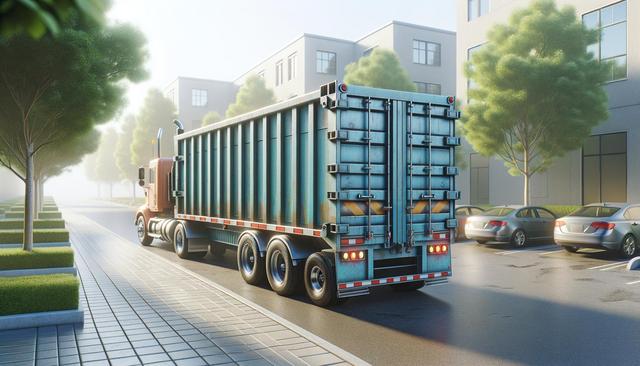Trailer Size and Capacity
One of the most important factors to consider when buying a dumpster trailer is its size and load capacity. Dumpster trailers come in a range of sizes, typically measured in cubic yards. Common sizes include 10, 14, and 20 cubic yards, but your choice should depend on the scale of work you plan to undertake. Larger trailers are more suitable for construction or demolition projects, while smaller ones may be ideal for landscaping or residential clean-outs.
In addition to volume, you’ll want to check the weight capacity. Each trailer has a Gross Vehicle Weight Rating (GVWR), which indicates the maximum weight it can safely carry, including the trailer’s own weight. Overloading a trailer can lead to safety risks and increased wear and tear. Make sure your vehicle can also handle the load, as towing capacity is equally important.
Key considerations include:
- Volume capacity (in cubic yards)
- Weight rating (GVWR)
- Compatibility with your towing vehicle
Evaluating these specifications upfront will help ensure you choose a trailer that aligns with your specific requirements.
Material and Build Quality
The durability of your dumpster trailer largely depends on the materials used in its construction. Steel is the most common material due to its strength and resistance to damage. However, the thickness of the steel and the quality of the welding can significantly impact longevity. A trailer built with heavy-gauge steel and reinforced joints will typically hold up better under heavy use.
Look for trailers with features like powder-coated finishes to resist rust and corrosion, especially if you’ll be using it in damp or humid environments. The type of flooring also plays a role; diamond plate steel floors offer superior traction and durability compared to wood floors, which can rot or warp over time.
Important build features to examine include:
- Steel gauge (thicker is usually better)
- Protective coatings (e.g., powder coat)
- Reinforced corners and joints
- Flooring material and design
Investing in a well-constructed trailer can reduce maintenance needs and extend its service life, making it a more cost-effective option over time.
Dumping Mechanism and Ease of Use
Another crucial feature to evaluate is the dumping mechanism. Most dumpster trailers are equipped with either a hydraulic or manual lift system. Hydraulic dump trailers offer greater convenience and efficiency, especially for frequent use, as they allow you to unload materials with minimal physical effort. Manual systems may be more affordable but can be labor-intensive and time-consuming.
Ease of use also includes features such as remote control options, battery-powered lifts, and tilt angles. A higher tilt angle can help ensure that all materials slide out smoothly without getting stuck inside the bin. Consider what kind of work you’ll be doing and how often you’ll need to unload the trailer when choosing a dumping system.
Useful ease-of-use features include:
- Hydraulic lifting systems
- Remote or push-button dumping controls
- High tilt angles for cleaner unloading
- Accessibility features like rear gates or side doors
Choosing a trailer with the right dumping system can significantly improve your workflow and reduce physical strain during regular operations.
Axles, Tires, and Suspension
The undercarriage of your dumpster trailer plays a pivotal role in its performance and safety. Axles, tires, and suspension systems must be able to handle both the weight of the load and the terrain where the trailer will be used. Tandem axles, for example, offer better weight distribution and stability compared to single axles, making them suitable for heavier loads and uneven ground.
When it comes to tires, opt for high-load-rated trailer tires designed for durability and road grip. Radial tires are often preferred for long-distance towing, while bias-ply tires may offer more rugged performance for off-road conditions. Suspension systems, such as leaf spring or torsion axles, affect how smoothly the trailer rides and how well it absorbs shocks.
Key components to consider:
- Number and type of axles (single vs. tandem)
- Load rating and type of tires
- Suspension type (leaf spring vs. torsion)
- Brake systems (electric or hydraulic)
Ensuring these components are aligned with your usage will contribute to safer and more efficient hauling, especially over rough or long-distance routes.
Additional Features and Customization Options
Depending on your needs, additional features and customization options can enhance the functionality and convenience of your dumpster trailer. Some trailers come with built-in toolboxes, tarp kits, or spare tire mounts. Others offer customizable sidewalls, lighting systems, and branding opportunities for business use.
It’s also worth considering the manufacturer’s warranty and availability of replacement parts. A trailer with a solid warranty and accessible customer support can provide peace of mind and long-term reliability. If you’re running a business, branding your trailer with your company logo or colors can help with visibility and marketing.
Popular customization options include:
- Removable or fold-down sides
- Integrated tarp systems
- LED lighting packages
- Custom colors and decals
- Tool storage compartments
These enhancements can make your trailer more versatile and tailored to your specific operational requirements, whether for personal or commercial use.
Conclusion: Choosing the Right Dumpster Trailer for Your Needs
Purchasing a dumpster trailer is a significant investment that requires careful consideration of multiple features. From size and build quality to axles and customization, each aspect plays a key role in overall performance and usability. Whether you’re a contractor, landscaper, or homeowner tackling large projects, selecting a trailer that matches your specific needs will help ensure safety, efficiency, and long-term value. Take your time to compare specifications, ask questions, and choose a well-regarded model that suits both your current tasks and potential future demands.






